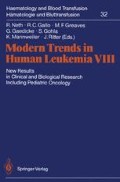Abstract
Several factors are involved in the high frequency of T-cell lymphomas of AKR mice, which appear mainly in the thymus at the age of 6–12 months [1]. The thymus is considered to play a major role in the disease since its removal prevents the development of T-cell lymphoma [2], while retransplantation of thymic epithelium to thymectomized AKR reconstitutes the high frequency of lymphoma [3], Although the AKR/J strain has the predisposition to develop the disease since birth [4], the mean latent period is delayed until the age of 8 months. The long latent period has been attributed to the delayed formation of the leukemogenic dual tropic virus (DTV) with the MCF characteristic [5, 6], formed in the thymus as a consequence of recombination within the envelope gene of ecotropic and xenotropic murine leukemia virus (MuLV). DTVs are detected only in preleukemic thymus and leukemic tissues of strains of mice prone to develop high incidence of leukemia [7]. DTVs enhance leukemia development whereas endogenous ecotropic or xenotropic viruses are usually nontumorigenic. Exceptional is the ecotropic virus isolate SL3 with the enhancing activity on T-cell lymphomagenesis [8]. These observations support the assumption that DTVs are proximal transforming agents of thymocytes and thereby responsible for high incidence of T lymphoma in AKR mice. Cloyd [9] proposed specific cellular tropism of two subclasses of MCF virus, and claimed that oncogenicity is closely linked to cellular differentiation. MCF isolated from lymphomatous thymus was replicating in the thymus and T peripheral cells, while nonlymphomagenic MCF isolated from leukemic spleen of NFS mice did not replicate in the thymus but rather in bone marrow cells, spleen, and lymph node B-lymphocytes.
Access this chapter
Tax calculation will be finalised at checkout
Purchases are for personal use only
Preview
Unable to display preview. Download preview PDF.
References
Furth J, Seibold HR, Rathbone RR (1933) Experimental studies on lymphomatosis of mice. Am J Cancer 19: 521–527
McEndy DP, Boom MB, Furth J (1944) On the role of thymus, spleen and gonads in the development of leukemia in high leukemic strain of mice. Cancer Res 4: 377–383
Hays E (1968) The role of thymus epithelial reticular cells in viral leukemiogenesis. Cancer Res 28: 21
Rowe WP, Pincus T (1972) Quantitative studies of naturally occurring murine leukemic virus injection of AKR mice. J Exp Med 135: 429–436
Hartely JW, Walford MK, Old LJ, Rowe WP (1977) A new class of mouse leukemia virus associated with development of spontaneous lymphomas. Proc Natl Acad Sci USA 74: 789–792
Elder JH, Gautsch JW, Jensen FC, Lerner RA, Hartely JW, Row WP (1977) Biochemical evidence that MCF murine leukemic viruses are envelope ( ENV) gene recombinants. Proc Natl Acad Sci USA 74: 4676–4680
Kawashima K, Ikeda H, Hartley JW, Stockert E, Rowe WP, Old LJ (1976) Changes in expression of murine leukemia virus antigens and production of xenotropic virus in the late preleukemic period in AKR mice. Proc Natl Acad Sci USA 73: 46810–4684
Hays EF, Levy JA (1984) Differences in lymphogenic properties of AKR mouse retroviruses. Virology 138: 49–57
Cloyd MW (1983) Characterization of target cells for MCF viruses in AKR mice. Cell 32: 217–225
Haran-Ghera N (1980) Potential leukemic cell among bone marrow of young AKR/J mice. Proc Natl Acad Sci USA 77: 2923–2926
Haran-Ghera N, Peled A, Hoffman AD, Leef F, Levy JA (1987) Enhanced AKR leukemogenesis by dual tropic viruses. I. The time and site of origin of potential leukemic cells. Leukemia 1: 442–449
Buckheit RV Jr, Bolognesi DP, Weinhold KJ (1987) The effects of leukemosuppressive immunotherapy on bone marrow infectious cell centers in AKR mice. Virology 157: 387–396
Peled A, Haran-Ghera N (1985) High incidence of B cell lymphomas derived from thymectomized AKR mice expressing TL.4 antigen. J Exp Med 162: 1081–1086
Bedigian HG, Shultz LD, Meier H (1979) Expression of endogenous murine leukemic viruses in AKR/J Strecker mice. Nature 279: 434–436
Fredrickson TM, Morse HC III, Rowe WP (1984) Spontaneous tumors of NFS mice congenic for ecotropic murine leukemic virus induction loci. J Nat Cancer Inst 73: 521–524
Peled A, Haran-Ghera N (1988) Prevention of T cell lymphoma in AKR/J mice. Leukemia 2: 125–131
Haran-Ghera N, Trakhtenbrot L, Resnitzky P, Peled A (1989) Preleukemic state in murine leukemogenesis. Leukemia (in press)
O’Donnell PV, Nowinski RC, Stockert E (1982) Amplified expression of murine leukemia virus (MuLV)-coded antigens on thymocytes and leukemic cells of AKR mice after infection by dual tropic ( McF) MuLV. Virology 119: 4510–464
Scollay R, Bartlett P, Shortman K (1984) T cell development in the adult murine thymus: changes in the expression of the surface antigens Ly-2, L3T4 and B2A2 during development from early precursor cells to migrants. Immunol Rev 82: 79–87
Stockert E, O’Donnell PV, Ohata Y, Old LJ (1988) Inhibition of AKR leukemogenesis by SMX-1, a dual tropic murine leukemia virus. Proc Natl Acad Sci USA 77: 37210–3724
DeRossi A, D’Andrea E, Biasi G, Gollavo D, Chieco-Bianchi L (1983) Protection from spontaneous lymphoma development in SJL/J (v+) mice neonatally injected with dual tropic SJL/151 virus. Proc Natl Acad Sci USA 80: 2775–2779
Author information
Authors and Affiliations
Editor information
Editors and Affiliations
Rights and permissions
Copyright information
© 1989 Springer-Verlag Berlin Heidelberg
About this paper
Cite this paper
Peled, A., Haran-Ghera, N. (1989). Intervention in Potential Leukemic Cell Migration Pathway Affects Leukemogenesis. In: Neth, R., et al. Modern Trends in Human Leukemia VIII. Haematology and Blood Transfusion / Hämatologie und Bluttransfusion, vol 32. Springer, Berlin, Heidelberg. https://doi.org/10.1007/978-3-642-74621-5_41
Download citation
DOI: https://doi.org/10.1007/978-3-642-74621-5_41
Publisher Name: Springer, Berlin, Heidelberg
Print ISBN: 978-3-540-50967-7
Online ISBN: 978-3-642-74621-5
eBook Packages: Springer Book Archive

